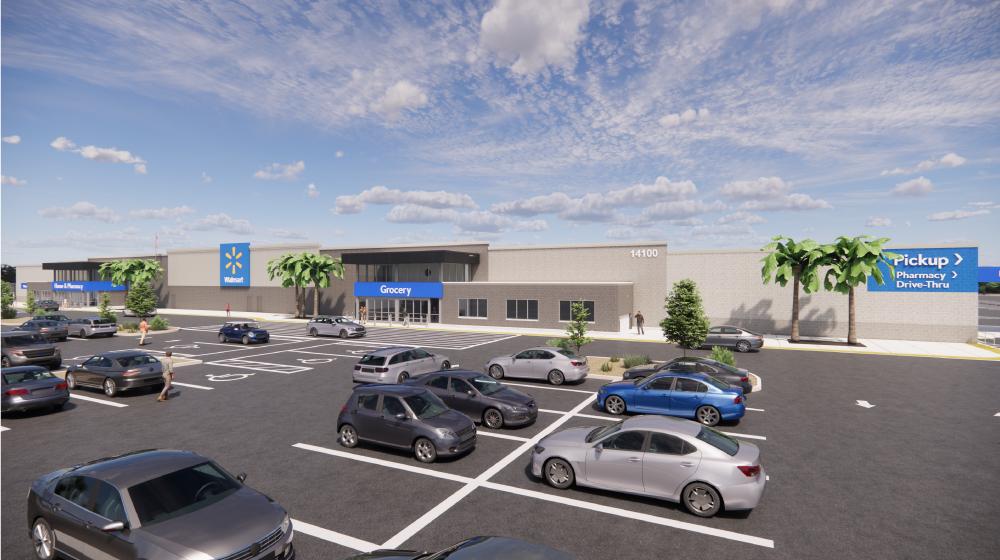Inside Walmart’s ‘Adaptive Retail’ Era
Here’s two things we know are true:
First, Walmart sells more groceries in physical stores than any other retailer in the United States. Second, Walmart sells more groceries online than any other retailer in the United States.
With those facts in mind, where could the company’s seemingly bulletproof value proposition for grocery possibly evolve next?
Walmart’s chief merchant and EVP, Latriece Watkins, knows the answer.
“The Walmart grocery value proposition — like everything we do — is rooted in our purpose, which is to help people save money and live better,” says Watkins. “To deliver that purpose, we have a customer value proposition based on having a quality assortment that we offer customers at everyday low prices. We combine those with our unique ability to provide customers a truly omni shopping experience in one of our more than 4,600 stores, on Walmart.com or both.”
According to Watkins, the company plans to continue to leverage its momentum in grocery “by working to understand customers’ evolving needs and innovating. This includes bringing innovation to our assortment in terms of quality and convenience, but also elevating the customer experience through technology.”
[REGISTER for the 2024 GroceryTech event]
What that innovation will look like becomes increasingly clear through talking with Watkins, as well as from comments made by other Walmart executives at the annual Consumer Electronics Show (CES) and National Retail Federation (NRF) trade shows earlier this year.
Assortment Quality and Convenience
Walmart U.S., which operated 4,717 stores and had annual sales of $420 billion in 2023, reported more than $247 billion in grocery sales last year, making it the No. 1 U.S. food retailer by a wide margin. The retailer’s fourth-quarter report, released in February, beat estimates and showed mid-single-digit comp growth in grocery, resulting in strong share gains (it already holds 25% of market share in U.S. grocery) in consumables, especially among higher-income households. Walmart’s customer value prop in grocery is just getting stronger with a growing cohort of value-seeking households, and the volatile macro environment is a big tailwind for the retailer.
Watkins, who was elevated to chief merchant last year after decades of service with the company, notes that the retailer is winning at grocery because its assortment strategy is focused on quality and convenience. Walmart’s assortment is curated with the goal of providing customers with quality products at an unexpected value, she adds. The retailer is also constantly improving and expanding its grocery assortment to satisfy consumer demand for national-brand and private-brand products with more flavor, variety and natural ingredients.
“We also think about lifestyle, so we build our assortment to enable customers to personalize their choices,” says Watkins. “This might include healthy options like gluten-free or plant-based products. … We want to be locally relevant, so we tailor assortment to the community. This might mean culturally specific baked goods, spices or other ingredients that uniquely reflect a community.”
Talking about the state of the (frugal) shopper, Watkins observes that the U.S. consumer continues to be stressed and is being careful when it comes to spend.
“It’s an interesting situation right now,” she admits. “On the one hand, the economy is doing really well, unemployment is low, and wages are growing. But our customers are telling us they’re feeling financially stretched. They’re concerned about inflation. We know this is true in grocery, because inflation has had a big impact on food prices over the past few years. Even though that’s easing a bit, customers are paying very close attention to how they spend. They’re making careful choices aimed at maximizing savings and value. We like to say we’re taking inflation out of the equation for our customers.”
[RELATED: What, Exactly, Is Value to Today’s Shoppers?]
During the holiday season, Walmart offered a Thanksgiving meal for a price lower than last year, effectively removing inflation on a holiday meal for eight to 10 people. According to Watkins, Walmart is doing it again for Easter this year.
But, believe it or not, value isn’t everything to today’s shopper, Watkins asserts. “Customers definitely want convenience,” she says, adding that because convenience is a priority, the retailer is doubling down on stocking meal solutions that offer busy families healthy, flavorful and easy-to-prepare options.
There’s yet another angle to Walmart’s focus on convenience for grocery shoppers.
“We enable that convenience with an omni shopping experience — giving customers the ability to shop however, wherever and whenever they want to,” notes Watkins, “and we’re continually giving them more and more options by expanding delivery with early-morning options starting at 6 a.m., late-night up to 10 p.m., or express delivery in three hours or less.”
Since 2000, when Walmart first created walmart.com and samsclub.com, the company’s e-commerce capabilities have exploded. In its most recent fiscal quarter, the retailer topped $100 billion in e-comm sales for the first time as large numbers of shoppers used curbside pickup and placed grocery delivery orders. The company’s digital strategy has focused on improving customer-facing initiatives in stores and clubs and creating a seamless omni experience for customers. As such, the company has allocated more capital to supply chain, omni initiatives, technology and store remodels, and less to new store and club openings. This investment includes the creation of a Walmart Global Tech division, which employs more than 28,000 associates globally and includes businesses such as Walmart Luminate, GoLocal and Walmart Data Ventures.
Today, Walmart U.S. has more than 4,600 pickup locations and more than 3,900 same-day delivery locations (plus 34 e-commerce fulfillment centers). Its Walmart+ membership offering provides enhanced omnichannel benefits, including unlimited free shipping on eligible items with no order minimum, unlimited delivery from a store, fuel discounts, access to the Paramount+ streaming service, and mobile scan and go for a streamlined in-store shopping experience.
Since Walmart has heavily invested in omnichannel and e-commerce innovation, Watkins explains how AI, generative AI and AR innovations will supercharge the retailer’s grocery strategy further.
[RELATED: 4 Reasons for Retailers to Embrace GenAI]
“We’re enhancing the digital shopping experience by using technology to create greater personalization and remove friction,” she says. “One great example of how we’re doing this is the AI-powered Walmart Shopping Assistant we’re currently testing that will bring a new level of simplicity and accuracy to the digital search experience for customers.” Gen AI search capabilities can work in cases where customers are shopping for an occasion versus shopping for items, she adds.
At CES, held in Las Vegas this past January, Walmart CEO Doug McMillon discussed how Walmart’s Shopping Assistant tool might support a customer looking to host a Super Bowl party.
“Instead of searching for chips, then dip, then drinks, paper plates or napkins, a customer might say, ‘Show me everything I need to host a Super Bowl party,’” he said. “That search will then generate suggestions for a range of food and general merchandise options for the customer to consider. It might also include items they hadn’t thought of. Once they place the order, they can decide if they want to pick it up or have it delivered.”
Speaking of grocery delivery, Walmart is expanding its InHome program, which delivers orders straight to a shopper’s kitchen, garage or doorstep. Tips are included, and no delivery fees or item markups are included. InHome will now feature replenishment, an AI-powered offering that aims to automatically order groceries when the customer needs them, and deliver them, too.
“It’s a feature we’re building using AI to get a personalized replenishment algorithm,” said Whitney Pegden, VP and GM, Walmart InHome, at CES. “It learns the customer’s purchase patterns to determine the perfect cadence to restock their essentials. So, the long list of things you purchase frequently, whether it’s the ones you need every week, or the things you need every 17 days, they’ll be there the moment you open the fridge or pantry. And you don’t have to lift a finger.”
Pegden made sure to emphasize that the new Walmart service isn’t a subscription (like Amazon’s Subscribe & Save program, for instance).
“For example, I know in my house, we consume a lot of yogurt, waffles, milk, some other things, but how much? And what exactly are those other things? Our replenishment service solves that. It’s personalized and adjusts based on your changing needs. Not only are we going to get you what you need, we’re going to get it to you when you need it, and even where you need it, right to your refrigerator,” she said.
The service even allows for vacations.
“You can adjust for that if, say, you know you’ll be away for vacation, and you don’t want more milk showing up,” observed Pegden. “That’s all in your control. Bottom line, the entire shopping experience is automated, from filling the basket to delivery to your refrigerator, whether that’s in your kitchen or your garage.”
Adaptive Retail
At CES, McMillon described business leaders as standing at a fork in the road, with two paths ahead.
“One path is to completely prioritize technology, to maximize what’s possible without considering the people implications,” he said, as the words “technology,” “people-led” and “tech-powered” flashed on a giant Walmart-blue screen behind him.
“Then there’s the other path,” he continued. “It’s more nuanced. It’s one where the benefits of technology are pursued, but people are considered along the way. This is by our heads and our hearts. The underlying principle is that we should use technology to serve people, and not the other way around. This path enables people to do things in more efficient and enjoyable ways.”
He asserted: “We’re choosing the second path.”
It was the first time that McMillon so eloquently made clear that Walmart intends to continue founder Sam Walton’s servant leadership legacy of “people first,” even in the face of relentless transformation — and competition — in the industry.
“Sam challenged us to design our business to make a bigger, more positive difference in our world,” said McMillon. “That’s what inspires us to solve problems and address our own imperfections. Making a real difference for so many families is what gets us up, and fires us up, every morning. … We love what technology can do, but we’re building it in a way that creates better careers at the same time it creates the best customer experiences, and a stronger business.”
[Never miss a story – sign up for Progressive Grocer's FREE Daily newsletter]
To tell the Walmart future story, McMillon used the opportunity of his keynote address — a first for the retailer at CES — to serve up the best and brightest minds from his executive leadership team. Of the company’s execs at the show, it was Suresh Kumar, EVP/global chief technology officer and chief development officer, who stole the show by introducing the retailer’s new mantra of “adaptive retail.”
“While omnichannel retail has been around for decades, this new type of retail — adaptive retail — takes it a step further,” observed Kumar. “It’s retail that is not only e-commerce or in-store, but a single, unified retail experience that seamlessly blends the best aspects of all channels. And for Walmart, adaptive retail is rooted in a clear focus on people.”
Walmart Global Tech SVP/COO Anshu Bhardwaj, who is scheduled to keynote Progressive Grocer’s GroceryTech event in Dallas this June, explained it as a bet on hyper-personalization.
“There’s a couple of buckets of retailers,” said Bhardwaj. “Some are still on the omnichannel journey, so they’re continuing to focus on the basics of omnichannel — buy online, pick up in store — making sure the customers know they have that option. I think these retailers will continue down that path. Then there’s another bucket, which is slightly ahead and continuing to invest in hyper-personalization. For us, we are turning into an adaptive retailer. … Omnichannel was bringing e-comm and brick and mortar together, right? Adaptive is: There’s so many other ways to shop, there’s so many other ways to discover.”
According to Bhardwaj, Walmart will continue adapting rapidly to what the customer needs.
“For example, we are adding drones,” she said. “Drone delivery is going to be available to millions of people in Dallas, and 75% of the products we have in a supercenter can be delivered through drones, which is massive.”
In January, Walmart placed a big bet on drones by expanding drone delivery across the DFW metro, marking the first time that a U.S. retailer has offered drone delivery to this many households in a single market. The deliveries will be powered by on-demand drone delivery providers Wing and Zipline. Both are approved by the FAA to fly their drones without a dedicated observer.
Drone delivery gives customers a faster delivery option, getting items to them in 30 minutes or less, and some deliveries can happen in as fast as 10 minutes. Popular Walmart orders via drone include rotisserie chicken and cold medicine.
[RELATED: Behind Walmart’s Burgeoning Drone Program]
“On the search side, generative search, we are offering text to shop, social shopping with friends,” added Bhardwaj. “So, whatever suits a consumer at a point in time, we will adapt to his or her needs and become a concierge. … I think where most retailers will be focused is going to be on the customer side, but some of the more savvy ones will want to start pivoting to associates, too. For us, that’s a big area of investment over the last five years, because if associates can’t shop the shelves, you won’t have sales in the store.”
People-Led
At the top of Walmart’s 10-K is its value proposition: We are a people-led, technology-powered omnichannel retailer dedicated to help people around the world save money and live better.
Bhardwaj isn’t kidding about the company’s investment in its more than 1.6 million associates in the United States and more than 2 million across the globe.
At CES, EVP/Chief People Officer Donna Morris talked about the retailer’s new tools for U.S. and Canada campus-based associates.
“Walmart is people-led and tech-powered, and we know that the best way to help our people reach their full potential is to provide the same intuitive, consumer-grade experience we’ve built for our customers and members,” said Morris. My Assistant, created in-house by Walmart’s Global Tech team, will enable associates to interact with the tool in their native language. From speeding up the drafting process, to serving as a creative partner, to summarizing large documents, My Assistant is poised to change how associates work and solve problems. That’s not the only new tool for Walmart employees, however.
“As customer expectations have changed, we’ve also accelerated the digital journey for our associates and built an app called Me@Walmart,” noted Morris. “This app gives our associates the ability to manage their schedules, gain new skills that can assist them in moving across roles in the company, and even make changes to personal benefits such as their 401(k) or stock purchase plan.”
As the company becomes more tech-powered, it will continue to evolve to support associate growth while also meeting the needs of customers, according to Morris.
“At the end of the day, we want people to grow and to thrive,” she added, “and we want everyone to know that they belong at Walmart. We are people-led and we are tech-powered, but it will always be our people that make the difference.”
Echoing her remarks, McMillon characterized Walmart’s future journey as really just a simple story about people.
“Today, we focus a lot on the technology that’s powering adaptive retail, and we described the future of shopping,” he said, “but remember that this is a story about people who are learning and adapting to make that future real. We all have a choice to choose a future that puts people first. If we keep doing that, we can help people around the world live a better life. That’s what we want. That’s the world we want to help create.”











